Leadership > TEST BANKS > PETER G. NORTHOUSE, LEADERSHIP: THEORY AND PRACTICE, SEVENTH EDITION: INSTRUCTOR RESOURCE TESTBANK (All)
PETER G. NORTHOUSE, LEADERSHIP: THEORY AND PRACTICE, SEVENTH EDITION: INSTRUCTOR RESOURCE TESTBANK
Document Content and Description Below
Chapter 1 – Introduction Multiple Choice 1. argued that the major activities of management and leadership are played out differently; but both are essential to an organization a. Jago b. Zalezn... ik c. Kotter d. Bass Ans: C Cognitive Domain: Knowledge Answer Location: Leadership and Management Question Type: MC 2. Power is described as a. A relational concern for both leaders and followers b. Use of force over others to manipulate them c. Letting any follower do whatever he or she wants d. Forcing people to engage in extreme behaviors Ans: A Cognitive Domain: Comprehension Answer Location: Leadership and Power Question Type: MC 3. The “Great Man/Person” trait definition of leadership a. Is about the interaction between leaders and followers b. Can be learned c. Is restricted to those with inborn talent, qualities, or characteristics d. Is about developing leadership skills Ans: C Cognitive Domain: Knowledge Answer Location: Leadership Described Question Type: MC 4. The four key elements of the definition of leadership used in the text are a. Trait, goal, emergent, expert b. Process, influence, group, goal c. Values, ethics, process, performance d. Capability, competency, skill, relationship Ans: B Cognitive Domain: Comprehension Answer Location: Leadership Defined Question Type: MC 5. In their discussion about management and leadership, Bennis and Nanus said that leaders a. “Do things right” b. “Do the right thing” c. “Do what followers want” d. “Do enough to get the job done” Ans: B Cognitive Domain: Comprehension Answer Location: Leadership and Management Question Type: MC 6. People in the organization like me because I know what I am doing and share knowledge with followers. I have a. Position power b. Personal power c. Information power d. Legitimate power e. Reward power Ans: B Cognitive Domain: Comprehension Answer Location: Leadership and Power Question Type: MC 7. Chief executive officers of any company have a. Legitimate power b. Referent power c. Expert power d. Personal power e. Emergent power Ans: A Cognitive Domain: Comprehension Answer Location: Leadership and Power Question Type: MC 8. I can emerge as the leader in my group project by a. Telling all group members exactly what to do b. Communicating and listening well with group members c. Sitting at the head of the table d. Being designated by the instructor as the group leader Ans: B Cognitive Domain: Comprehension Answer Location: Assigned versus Emergent Leadership Question Type: MC 9. Kellerman argues that in the last forty years there has been a shift in leadership power from a. Shared power to top down power b. Leader dominated power to shared power with followers c. Follower dominated power to shared power with leaders d. Referent power focus to coercive power focus Ans: B Cognitive Domain: Analysis Answer Location: Leadership and Power Question Type: MC 10. Information power is a. Associated with having formal job authority b. Based on followers liking of their leader c. Derived from having the ability to provide rewards d. Focused on the social contract between leaders and followers e. Derived from possessing knowledge that others want or need Ans: E Cognitive Domain: Knowledge Answer Location: Leadership and Power Question Type: MC 11. Who is said to engage leadership? a. Followers b. Groups c. Organizations d. Leader s Ans: D Cognitive Domain: Analysis Answer Location: Definition and Components Question Type: MC 12. Who is responsible for the leadership process? a. Followers b. Leaders c. Organizations d. Followers and leaders Ans: D Cognitive Domain: Analysis Answer Location: Definition and components Question Type: MC 13. The common goals element of the definition of leadership means a. Leaders and followers have a mutual purpose b. Leaders and followers have similar personalities c. Leaders and followers have similar interests d. Leaders and followers have a mutual desire for power Ans: A Cognitive Domain: Comprehension Answer Location: Definition and components Question Type: MC 14. The statement “She/he is born to be a leader” suggests a a. Process definition of leadership b. Trait definition of leadership c. Gender bias definition of leadership d. Coercive definition of leadership Ans: B Cognitive Domain: Comprehension Answer Location: Definition and components Question Type: MC 15. Social identity theory would suggest leadership emergence occurs when a. The group identifies with the leader b. They acquire the skills to do the job well c. The group assigns them the role of leader d. They become most like the group prototype Ans: D Cognitive Domain: Comprehension Answer Location: Assigned versus Emergent Leadership Question Type: MC 16. Coercive leadership a. Is not allowing a player to play in competition because he or she was late to practice b. Is forcing followers to engage in extreme behaviors c. Is using the influence relationship to affect change d. Is supporting ethical behavior amongst team members Ans: B Cognitive Domain: Analysis Answer Location: Leadership and Coercion Question Type: MC 17. To coerce means to a. Influence others toward a common goal b. Influence others to behave ethically c. Influence others to do something against their will d. Influence others using positive rewards Ans: C Cognitive Domain: Comprehension Answer Location: Leadership and Coercion Question Type: MC 18. Non-leadership is a. A relational interaction between a group of people toward common goals b. Sharing goal development with followers c. Leadership that is focused on individual goals d. Leadership that is focused on working with followers to achieve common goals Ans: C Cognitive Domain: Comprehension Answer Location: Leadership and Coercion Question Type: MC 19. The primary functions of leadership are a. Directing, ruling, encouraging b. Aligning, visioning, inspiring c. Building, maintaining, staffing d. Budgeting, controlling, problem solving Ans: B Cognitive Domain: Comprehension Answer Location: Leadership and Management Question Type: MC 20. Simonet and Tett (2012) found that management is distinct from leadership by a. Extrinsic motivation b. Intrinsic motivation c. Strategic planning d. Creative thinking Ans: A Cognitive Domain: Comprehension Answer Location: Leadership and Management Question Type: MC 21. Differences between management and leadership include a. Leaders are emotionally involved, whereas managers have low emotional involvement b. Managers shape ideas, whereas leaders are reactive in solving problems c. Leaders are unidirectional influencers, whereas managers are multidirectional influencers d. Leaders are controlling, whereas managers are motivating Ans: A Cognitive Domain: Comprehension Answer Location: Leadership and Management Question Type: MC 22. The primary functions of management are a. Producing change and movement b. Producing positive leadership outcomes c. Producing a creative vision d. Producing order and consistency Ans: D Cognitive Domain: Comprehension Answer Location: Leadership and Management Question Type: MC 23. One key to emerging as a leader a. Is to be perceived by others as likable and knowledgeable b. Is to be forceful in asserting your opinions c. Is to avoid listening to opposing opinions d. Is to be perceived by others as commanding and dominant Ans: A Cognitive Domain: Comprehension Answer Location: Assigned versus Emergent Question Type: MC 24. Which of the following bases of power are considered personal power? a. Information b. Referent c. Coercive d. Reward e. Legitimate Ans: B Cognitive Domain: Comprehension Answer Location: Leadership and Power Question Type: MC 25. Scholarly research and popular work on the nature of leadership exploded in this decade a. 1950 b. 1960 c. 1970 d. 1980 Ans: D Cognitive Domain: Knowledge Answer Location: Leadership Defined Question Type: MC 26. The emerging approach called servant leadership a. Focuses on followers needs b. Focuses on traits c. Focuses on adapting to solve problems d. Focuses on spirituality Ans: A Cognitive Domain: Comprehension Answer Location: Leadership Defined Question Type: MC 27. Which way of classifying leadership involves capabilities to make leadership possible? a. Group process b. Personality c. Skills d. Power Ans: C Cognitive Domain: Comprehension Answer Location: Leadership Defined Question Type: MC 28. The process definition of leadership implies a. Leadership is linear b. Leadership is one-way, top-down c. Leadership is leader centered d. Leadership is reciprocal between leaders and followers Ans: D Cognitive Domain: Knowledge Answer Location: Definition and Components Question Type: MC 29. Although there are clear differences between management and leadership, a. There is little research to support one or the other b. Leadership is more valued than management c. The two constructs overlap d. Management is more valued than leadership Ans: C Cognitive Domain: Comprehension Answer Location: Leadership and management Quest....................................................................................................CONTINUED [Show More]
Last updated: 2 years ago
Preview 1 out of 464 pages
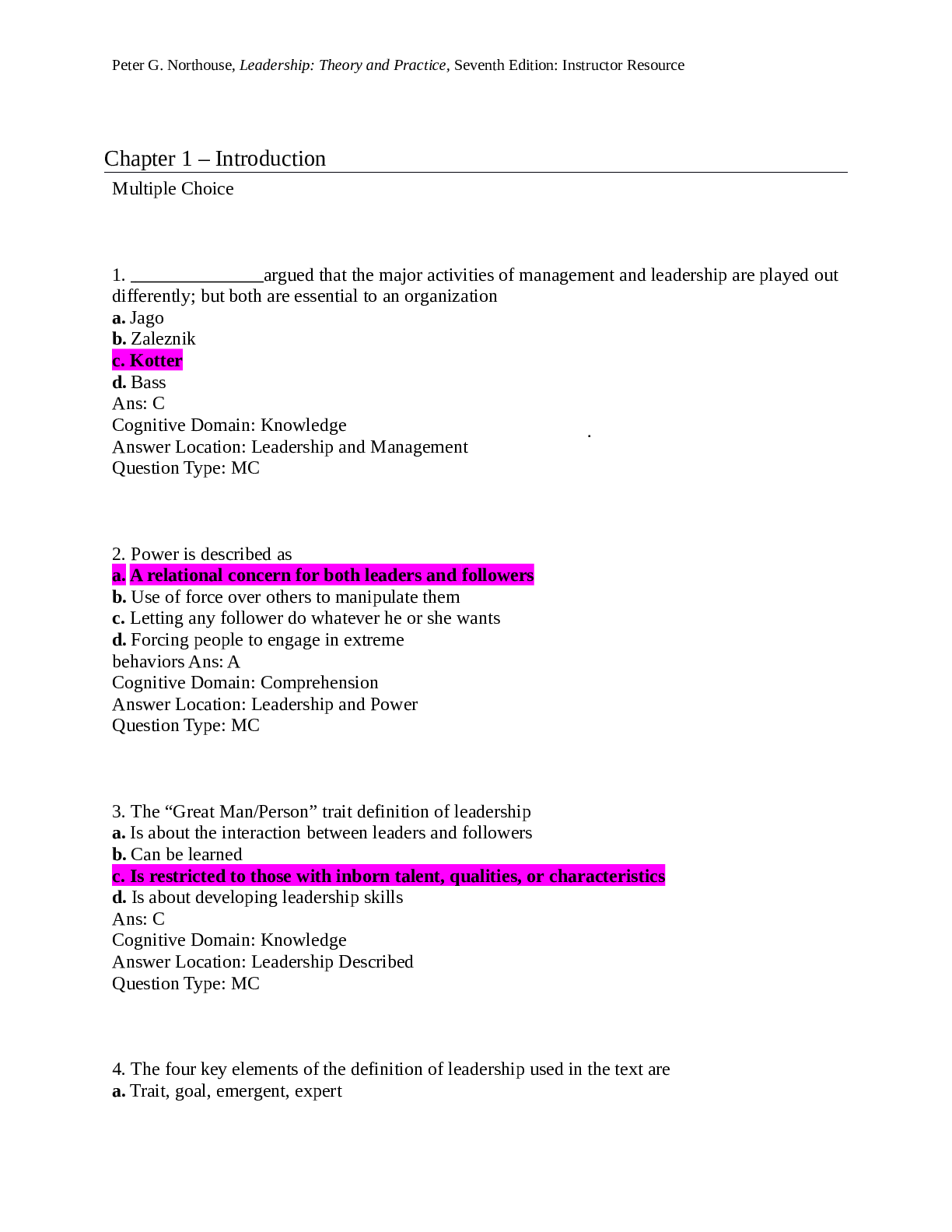
Buy this document to get the full access instantly
Instant Download Access after purchase
Buy NowInstant download
We Accept:

Reviews( 0 )
$25.00
Can't find what you want? Try our AI powered Search
Document information
Connected school, study & course
About the document
Uploaded On
Dec 21, 2021
Number of pages
464
Written in
Additional information
This document has been written for:
Uploaded
Dec 21, 2021
Downloads
0
Views
113

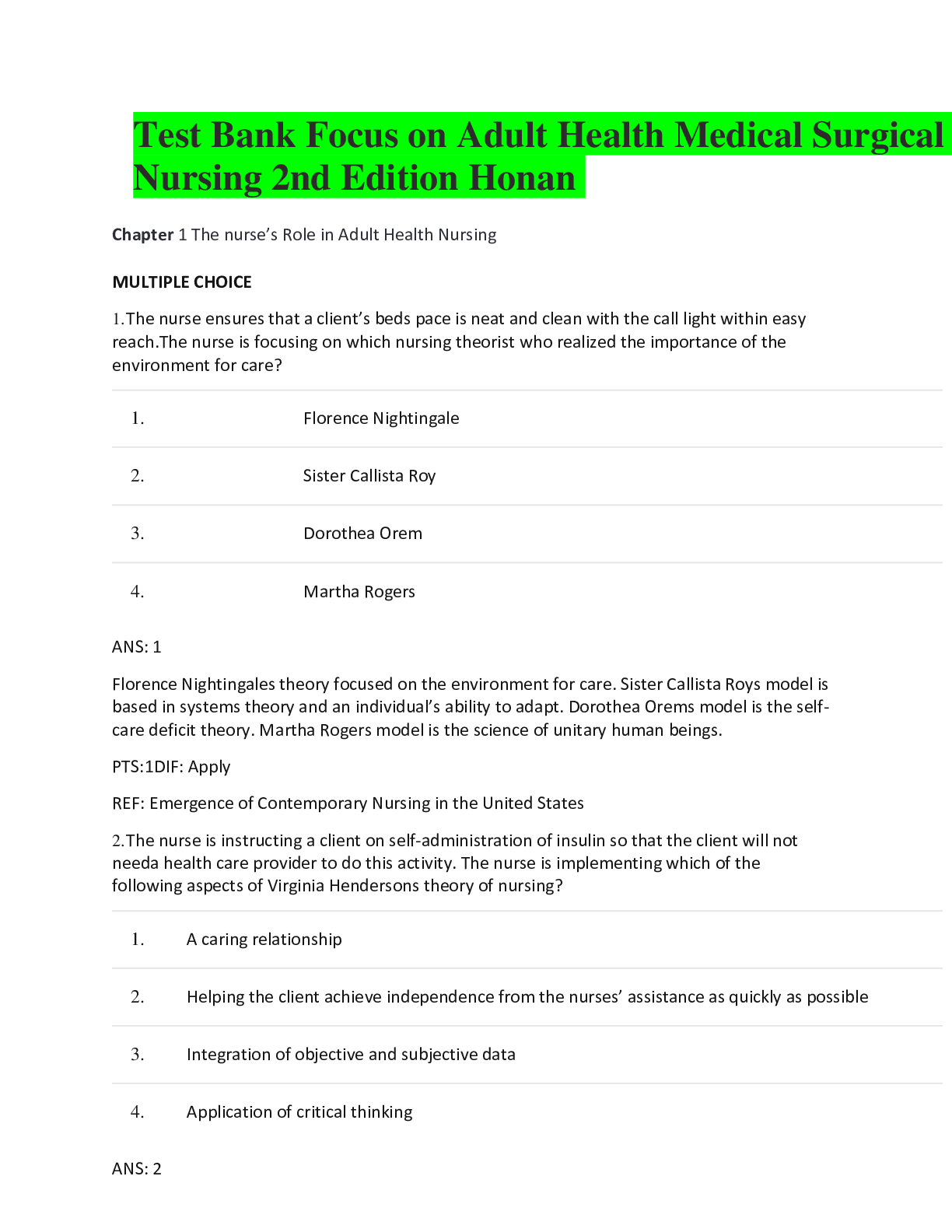
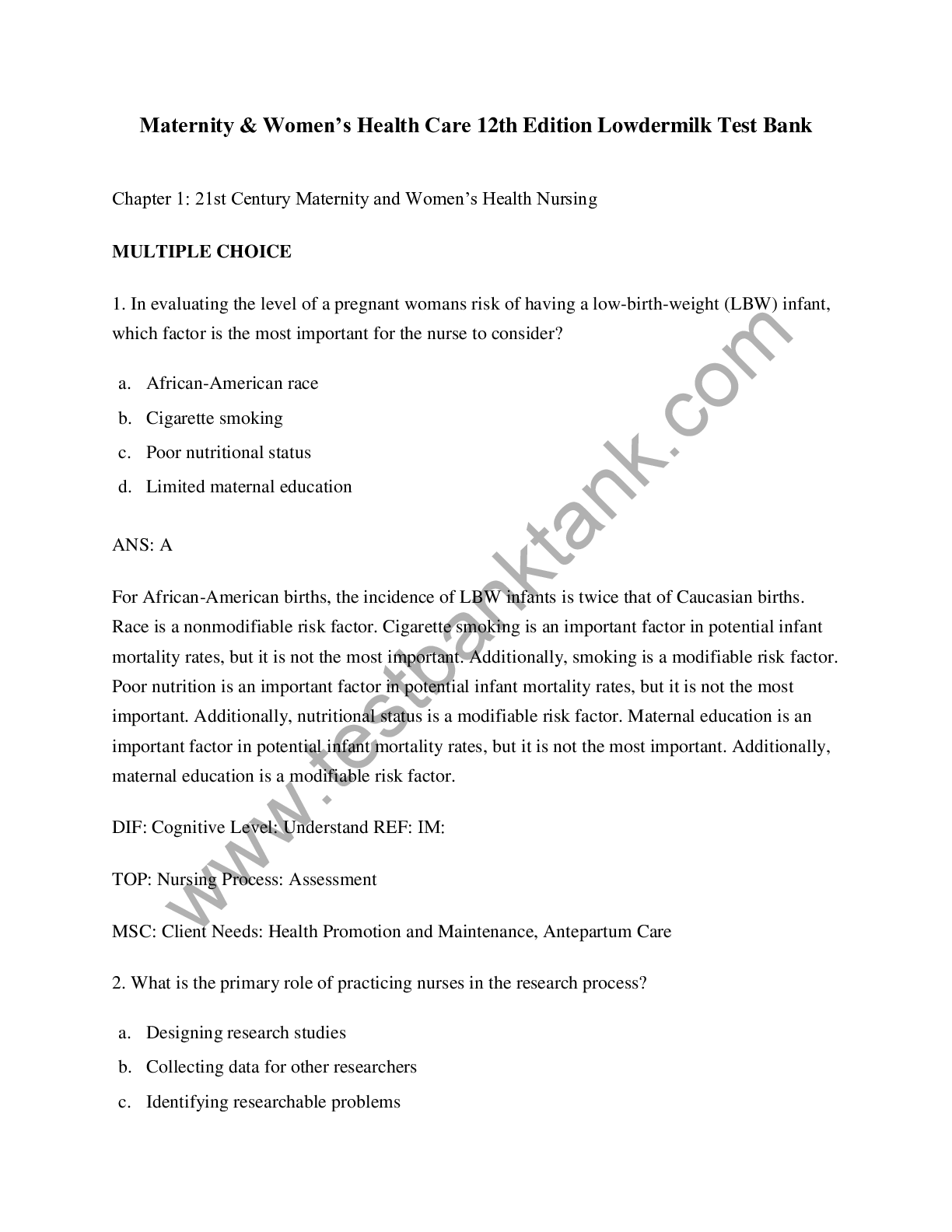
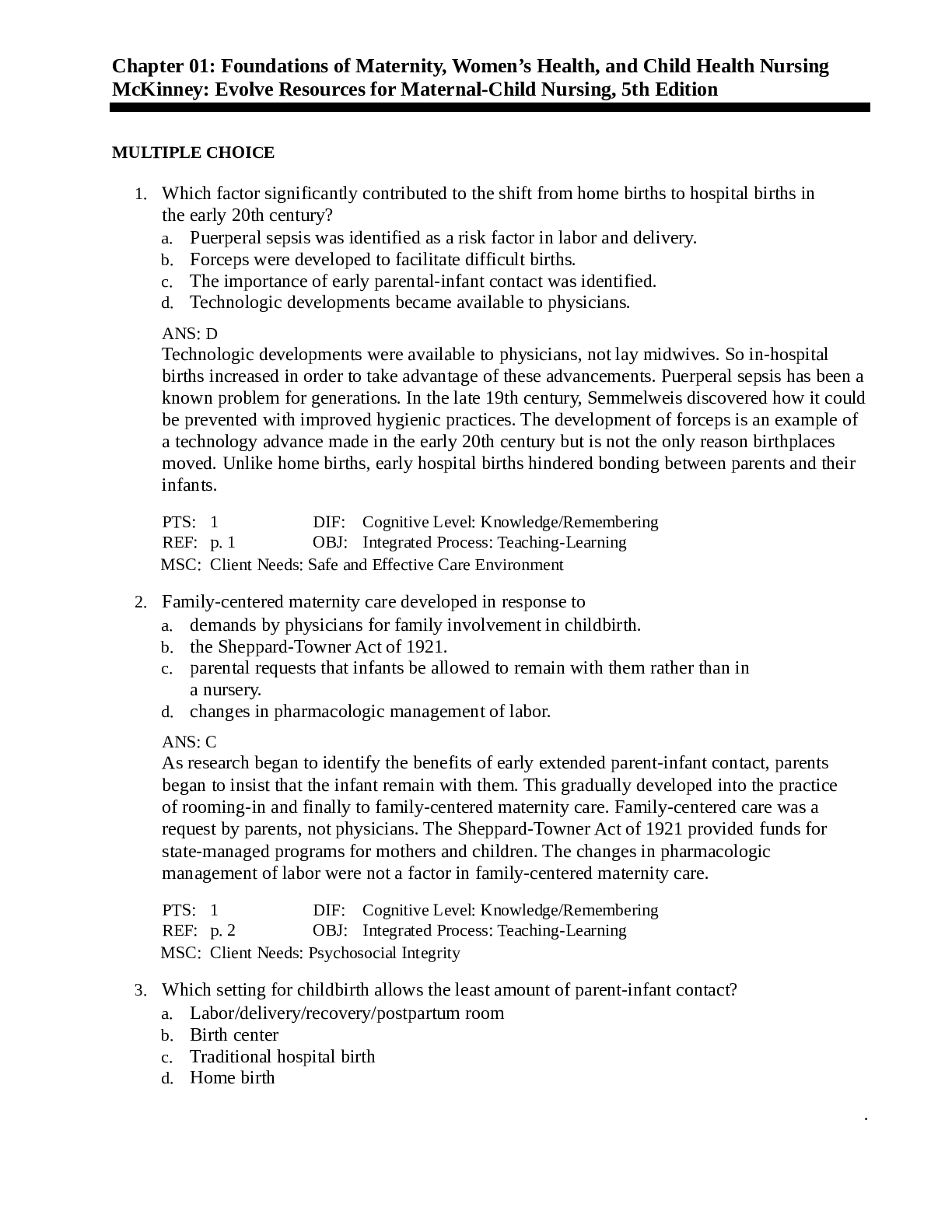

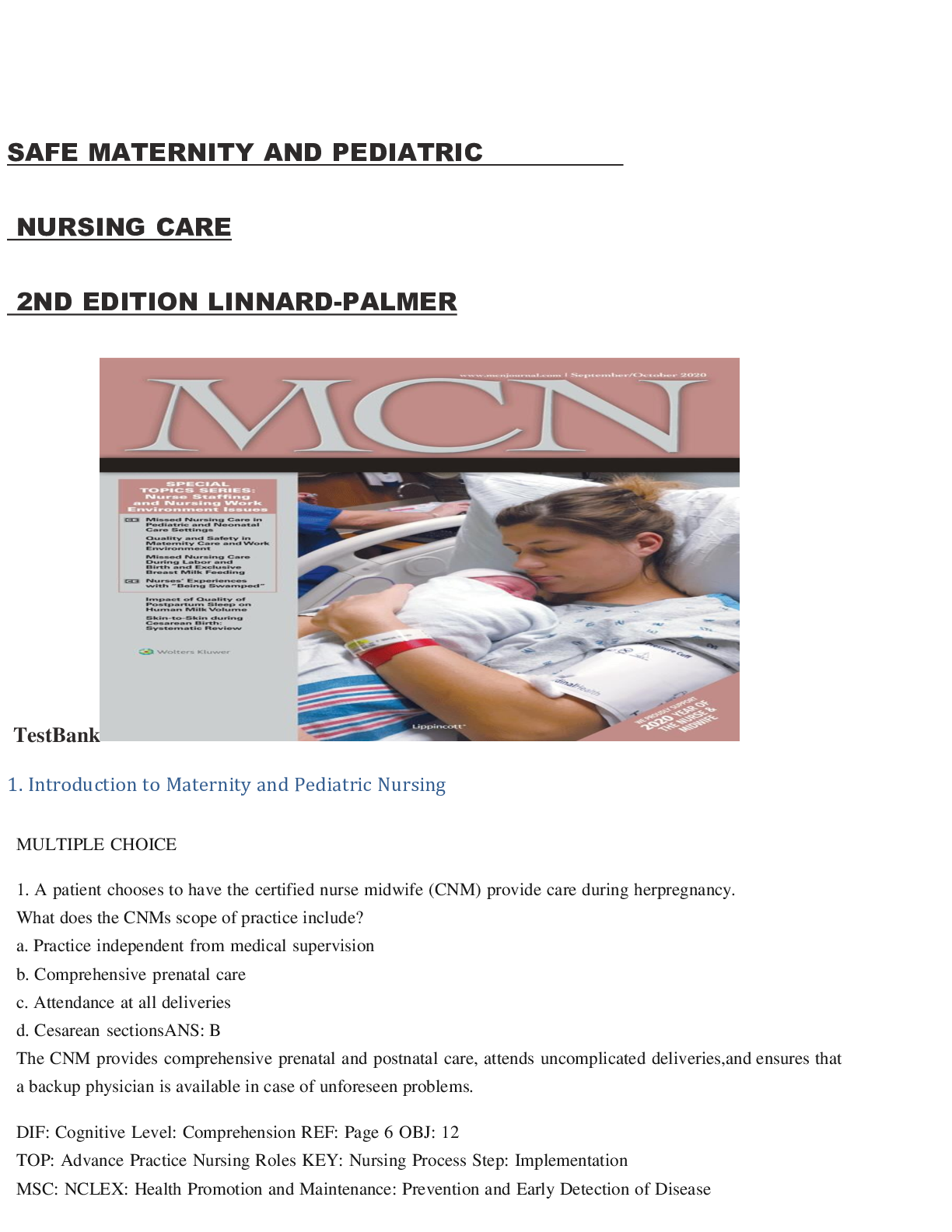


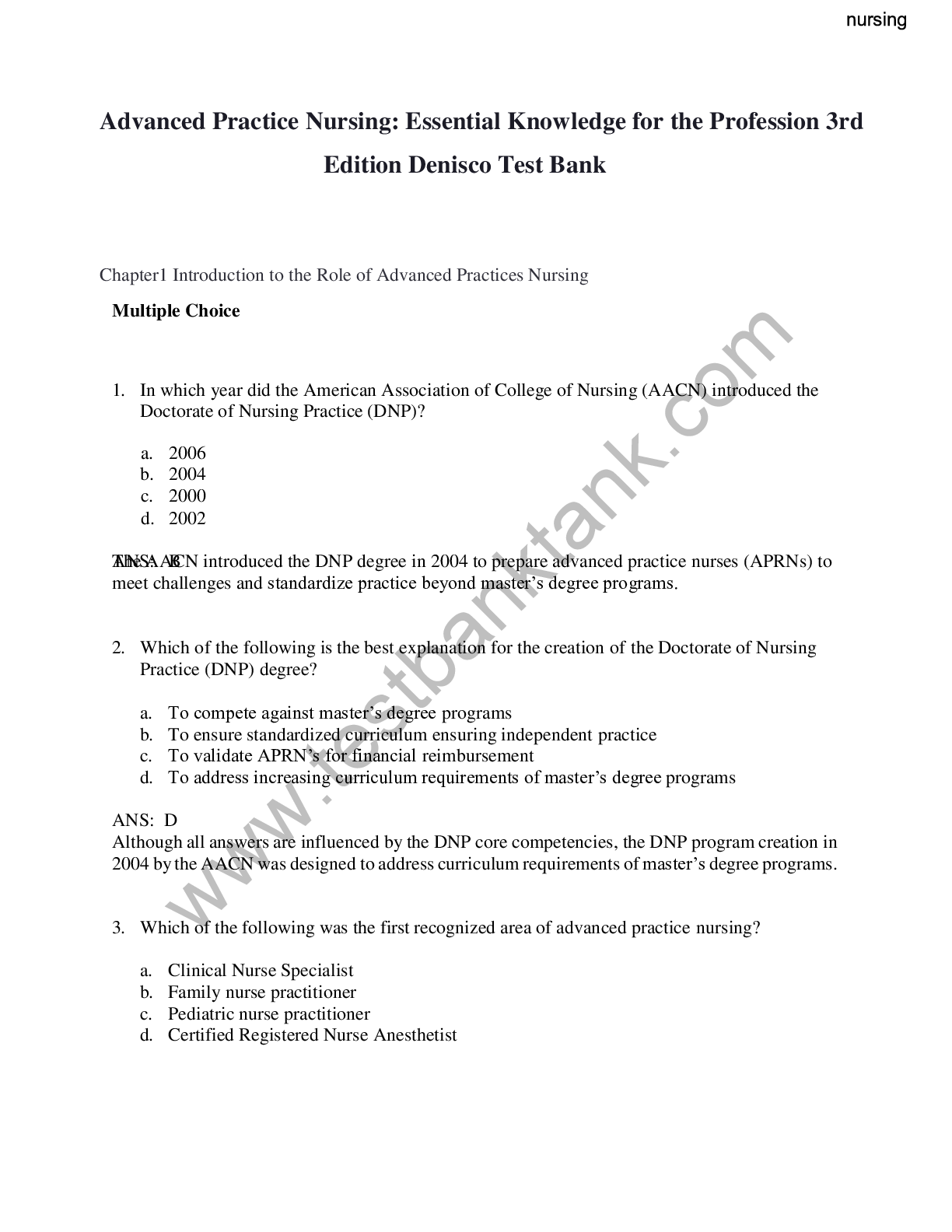



.png)

